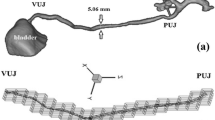Summary
Following a morphological analysis of pelvi-calyceal systems (PCS) of healthy persons and urolithiasis patients, rheological studies from glass and rubber PCS-models are presented. In the PCS of urolithiasis patients morphological and geometrical differences were found, causing a flow pattern which favours calculus formation. In urolithiasis, the PCS is characterized by cavities with significantly reduced flow rates and stagnation of urine. The formation of urinary calculi is often promoted by a hypomotility of the muscles of the PCS, common in urolithiasis patients. Possible therapeutic and diagnostic consequences are discussed.
Similar content being viewed by others
References
Arnold W, Seemann N (1968) Vergleichende infrarot-spektrophotometrische und pathomorphologische Untersuchungen zur Urolithiasis. Dtsch Med Wochenschr 93:1757–1791
Auvert J (1957) Ledeflux à partir du bassinet. Rapport et informations de la 51ième session de l'Ass Franc d'Urol, Paris
Brandner IS (1976) Die pathologischen Veränderungen des Nierenhohlraumsytems und ihre operative Behandlung. Dissertation, TU München
Brundig P, Schulz E (1986) Pathologisch-morphologische Parameter des Nierenbeckenkelchsystems als mögliche Ursache der häufig rezidivierenden und einseitigen Kalziumoxalatnephrolithiasis. Aktuel Urol 17:137–140
Düx A, Thurn P, Kisseler B (1967) Der physiologische Entleerungsmechanismus der ableitenden Harnwege im Röntgenkinematogramm. Fortschr Röntgenschr 97:687–703
Finlayson B, Reid F (1978) The expectation of free and fixed particles in urinary stone disease. Invest Urol 15:442–448
Floris F, Riga E (1979) Urinary flow hydrodynamics in the “boxshaped” and “funnel-shaped” pelvis. Urologia (Italia) 46: 723–728
Hannappel J (1984) Physiologie der oberen Harnwege. Therapiewoche 34:6488–6500
Hajos E (1978) Telescreen and radiographic examination of urinary transport. Akademiai Kiado, Budapest
Hautmann R (1980) Entwicklung und Behandlung von Kalziumoxalatsteinen. Therapiewoche 30:8162–8172
Lullies H, Trincker D (1974) Taschenbuch der Physiologie. Bd I. Fischer, Jena
Marberger H (1965) Hydrodynamics problems of modern urology. Z Urol Nephrol 58:871
Randall A (1936) Hypothesis for origin of renal calculus. New Engl J Med 214–234
Schmidt H (1978) Motilität der oberen harnwege. Springer, Berlin Heidelberg New York
Schulz E (1983) Nutzung der Modelltechnik zur Ermittlung des Strömungseinflusses auf die Harnsteinbildung im Nierenbecken-Kelchsystem. Dissertation, Hochschule für Verkehrswesen “Friedrich List”, Dresden
Schulz E, Hackeschmidt M (1983) Die mechanische Beanspruchung von “fixed particles”. Eine strömungstechnische Untersuchung an dynamischen Nierenmodellen. VIII. Jenaer Harnsteinsymposium. Wiss Beitr der FSU Jena 1984:24–30
Schulz E, Schneider HJ (1981) Der mögliche Einfluß der Form des Nierenbecken-Kelch-Systems auf die Harnsteingenese. Ungarischer Urologenkongreß 9./10. 10. 1981 kecskemet/Ungarn (Tagungsband)
Schulz E, Schneider HJ (1980) A new view on stone formation under the aspect of flow dynamics. In: Urolithiasis. Clinical and basic research on urolithiasis research. Plenum Press, New York, pp 533–538
Schulz E, Schneider HJ (1980) Ermittlung des harnvolumens im Nierenbecken-Kelch-System (NBKS) aus Urogrammen. Z Urol Nephrol 74:651–655
Schulz E, Hackeschmidt M, stadie G (1982) Strömungstechnische Analyse des Pyelon-Kelch-Systems hinsichtlich der Steingenese. I. Theoretische Aussagen. Z Urol Nephrol 75:699–710
Schulz E, Hackeschmidt M, Stadie G (1982) Strömungstechnische Analyse des Pyelon-Kelch-Systems hinsichtlich der Steingenese. II. Erste experimentelle Ergebnisse. Z Urol Nephrol 75:771–779
Schulz E, Hackeschmidt M, Stadie G (1984) Strömungstechnische Analyse des Pyelo-Kelch-Systems hinsichtlich der Steingenese. III. Untersuchungen an dynamischen Modellen. Z Urol Nephrol 77:589–597
Schulz E, Hengst E, Brundig P, Haerting R, Pirlich W, Günther H (1987) Disturbed urinary transport in the pelvicalyceal system in calcium-oxalate stone patients. Urol Res 15:109–113
Seyfarth HH, Schneider HJ (1979) Mikroskopische Gefügeanalysen von Harnsteinen und ihre Aussagen zur steingenese. VI. Jenaer Harnsteinsymposium 1979. Wiss Beitr der FSU Jena 1980:32–37
Seyfarth HH, Schneider HJ (1979) Strömungsmechanische Untersuchungen an Mikrogefügeanalysen und ihre Aussagen zur Harnsteingenese. VI. Jenaer Harnsteinsymposium 1979, Wiss Beitr der FSU Jena 1980:59–62
Weber E (1972) Grundriß der biologischen Statistik. Fischer, Jena
Zechner O, Loebenstein TH (1983) Experimentelles Harnsteinwachstum in vitro. VIII. Jenaer Harnsteinsymposium 1983. Wiss Beitr der FSU Jena 1984:42–48
Author information
Authors and Affiliations
Rights and permissions
About this article
Cite this article
Schulz, E. Studies on the influence of the flow field in the pelvi-calyceal system (PCS) on the formation of urinary calculi. Urol. Res. 15, 281–286 (1987). https://doi.org/10.1007/BF00258196
Accepted:
Issue Date:
DOI: https://doi.org/10.1007/BF00258196



